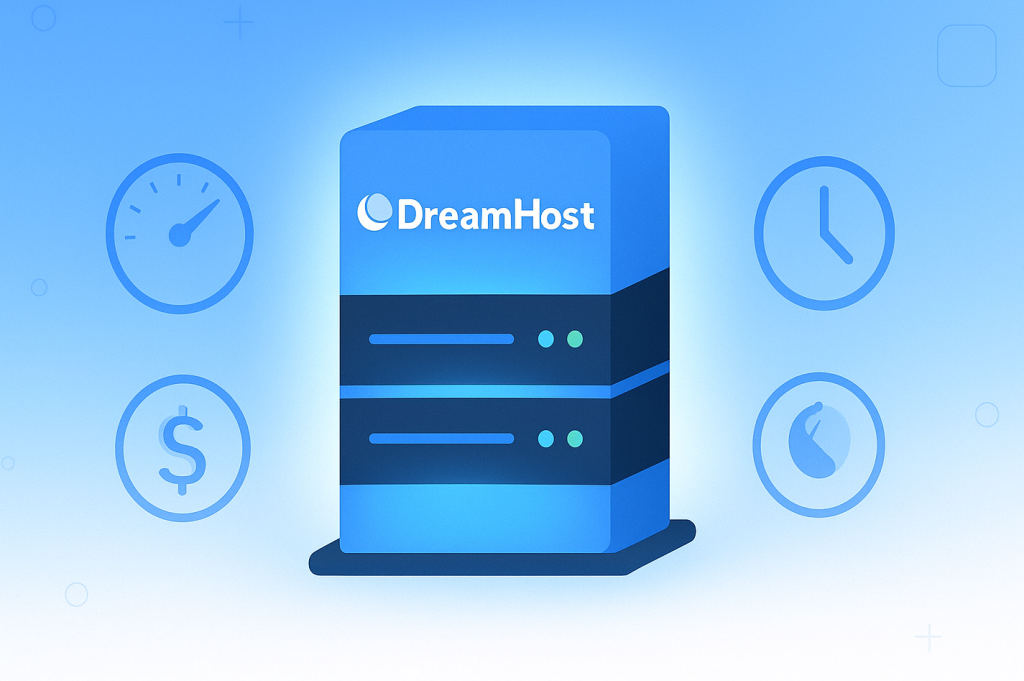In an industry often criticized for aggressive upsells, confusing pricing tiers, and shocking renewal fees, DreamHost stands out as a rare beacon of transparency and fairness. Founded in 1997 and one of the few independently-owned hosting giants left, DreamHost has built its reputation by doing things differently. It focuses on simplicity, includes essential features for free, and is one of only three hosting providers officially recommended by WordPress.org.
DreamHost’s philosophy caters directly to website owners who prioritize ethical business practices and predictability over chasing the absolute cheapest introductory rate.
But in 2025, where rivals are using cutting-edge LiteSpeed servers or Google Cloud infrastructure, the central question is: Can DreamHost’s commitment to fairness and independent operation match the speed and performance of its high-tech, corporate-backed competitors?
This detailed review dissects the DreamHost offering, covering its highly competitive pricing model, its unique custom control panel, performance metrics, and the crucial limitations in its customer support structure.
Part 1: Pricing and The Transparency Advantage
The most compelling reason to choose DreamHost is its commitment to transparent, predictable pricing. Unlike almost every other major shared host (Bluehost, HostGator, Hostinger), the jump from the introductory rate to the renewal rate is significantly less punitive, making long-term budgeting much easier.
1. The Low Barrier to Entry
DreamHost offers two main shared hosting tiers under its “Shared” product line:
| Plan Tier | Introductory Price (36-Month) | Key Features |
|---|---|---|
| Shared Starter | $2.59/mo | 1 Website, Free Domain (1 year), 50GB SSD Storage. |
| Shared Unlimited | $3.95/mo | Unlimited Websites, Unlimited SSD Storage, Free Email Hosting. |
The Shared Unlimited plan is the clear winner for value, granting unlimited websites and the essential inclusion of professional email hosting, a feature that the cheaper Shared Starter plan notably omits.
2. The Renewal Rate Reality Check
This is the area where DreamHost truly shines. While the price does increase upon renewal, the hike is modest compared to the industry average.
- A Shared Starter plan starting at $2.59/mo typically renews around $6.99/mo.
- A Shared Unlimited plan starting at $3.95/mo typically renews around $9.95/mo.
These renewal rates are significantly lower than what you would pay with Bluehost or SiteGround after their promotional periods end. This predictability reduces the anxiety of long-term hosting costs and eliminates the hassle of switching hosts purely to avoid a massive renewal bill.
3. Essential Free Inclusions
DreamHost integrates features that many competitors nickel-and-dime for, adding substantial value to the basic price:
- Free Domain Privacy Protection: This crucial security feature keeps your personal contact information hidden from public WHOIS records, a service that many hosts (like GoDaddy and HostGator) charge $10–$15 annually for. DreamHost includes it for free on all domains hosted.
- Free Daily Backups: Automated, daily backups are included at no extra cost, providing vital protection and an easy restore point should a mistake be made or a security issue arise.
- Longest Money-Back Guarantee: DreamHost offers an industry-leading 97-day money-back guarantee. This far exceeds the standard 30-day window and shows extreme confidence in their service.
Part 2: Performance and Reliability Metrics
DreamHost focuses heavily on reliability and utilizes high-speed Solid-State Drive (SSD) storage across all its plans. While it doesn’t utilize cutting-edge technology like LiteSpeed, its infrastructure is built for stability.
1. Uptime Commitment and Results
DreamHost offers one of the strongest Uptime Guarantees in the business: 100%. If your service dips below 100% availability in a given month due to issues within DreamHost’s control, you are credited for the time your site was unavailable.
- Real-World Uptime: Independent monitoring consistently shows DreamHost delivering uptime in the 99.95% range. While 100% uptime is almost impossible to achieve in reality, this result is excellent and aligns with top performers like SiteGround and Bluehost.
- SSD Storage: The use of SSDs (instead of slower Hard Disk Drives) across the entire platform ensures faster file and database access, which is a major factor in overall load time.
2. Speed Performance
DreamHost’s speed performance is respectable and consistent, but it falls slightly behind the top-tier speed leaders (like Hostinger with LiteSpeed).
- Average Load Times: Optimized WordPress sites hosted on DreamHost generally load in the 1s to 1.2s range. This is faster than older-generation hosts like HostGator but may not be as quick as the 450ms achievable on fully optimized LiteSpeed platforms.
- Built-in Caching: DreamHost provides built-in, server-side caching specifically optimized for WordPress. This helps bridge the gap with high-speed competitors, ensuring content is delivered efficiently, especially to repeat visitors.
Performance Verdict: DreamHost provides a very stable and reliable platform. It is fast enough to keep your visitors engaged and satisfy Google’s Core Web Vitals, but it requires less configuration and technical knowledge than trying to optimize a cheaper, slower host.
Part 3: The User Experience: Custom Panel and Developer Focus
DreamHost is known for moving away from industry standards in favor of custom solutions designed for efficiency.
1. The Custom Control Panel (No cPanel)
Like SiteGround and Hostinger, DreamHost ditched the traditional cPanel long ago, opting instead for a custom-built control panel.
- Pros: The interface is clean, modern, and highly task-focused. It’s designed to make complex actions (like managing domains, activating SSL, or accessing database tools) simpler for users.
- Cons: If you are a developer or agency veteran used to the universal layout of cPanel, there will be a significant learning curve. You’ll need to spend time navigating the custom menus to locate familiar functions.
2. Excellent Developer Support
Despite its beginner-friendly veneer, DreamHost is highly regarded by the developer community.
- SSH Access: All plans include full SSH access, which is essential for developers who need command-line control over their sites for tools like WP-CLI or automated deployments.
- Advanced Features: Users have access to modern PHP versions, built-in staging tools (on DreamPress plans), and support for advanced deployment methods, making it a surprisingly powerful option for those who eventually need more technical freedom than a standard shared host offers.
Part 4: The Critical Flaw: Customer Support Limitations
If DreamHost has one major weakness, it is in its customer support structure, particularly the lack of free, immediate phone support.
1. Support Channels
DreamHost offers support through three main channels:
- Live Chat: Available daily, but only during specific business hours (typically 5:30 AM to 10:00 PM Pacific Time). During peak hours, wait times can be substantial.
- Ticket System: Available 24/7, providing detailed, high-quality answers. This is the best option for complex, non-critical issues.
- Phone Support (Paid): DreamHost does not provide a free customer service phone number. Users can purchase phone callback services for an extra fee, a major drawback for businesses that require immediate, voice-based resolution during a site emergency.
2. Support Verdict
While the quality of the technical support provided via tickets is excellent, the limitation on live chat hours and the paid phone support option is a significant consideration. If you are launching a business-critical website and need the peace of mind that comes with 24/7 instant phone access (like SiteGround or Bluehost offer), DreamHost’s support model may be frustrating.
Final Verdict: Is DreamHost Worth It in 2025?
Yes. DreamHost is an outstanding choice for users who prioritize ethical pricing, control, and long-term budget predictability above all else.
It is one of the safest and most honest entry points into web hosting, backed by an impressive 97-day money-back guarantee and an infrastructure that, while not bleeding-edge fast, is consistently stable and reliable.
Who Should Choose DreamHost?
- WordPress Users: The official endorsement and optimized platform make it a natural fit for any WordPress-based project.
- Budget-Conscious Long-Termers: If you know you will host your site for three years or more, DreamHost’s low renewal rates provide exceptional long-term value compared to high-renewal competitors.
- Developers and Tech-Savvy Bloggers: The free domain privacy, SSH access, and general control over your environment are significant perks.
Who Should Look Elsewhere?
- Users Needing Instant Phone Support: If 24/7 phone access is non-negotiable for your business, you should look at providers like Bluehost or HostGator.
- The Absolute Speed Hunter: If achieving 400ms load times is your primary goal, a LiteSpeed-based host like Hostinger will be faster, though likely less transparent on pricing.
The Bottom Line: DreamHost is the conscientious choice in web hosting. It’s an easy-to-use, reliable, and highly ethical company that delivers a superior, no-nonsense product without the common traps and hidden fees that plague the rest of the industry.



